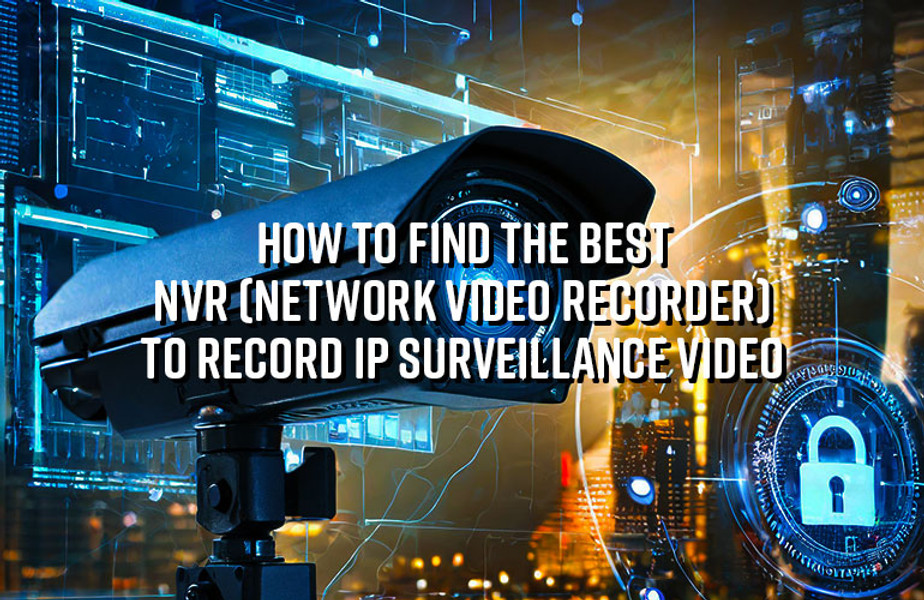The network security camera is only half the surveillance equation. You also need to store surveillance video to have the evidence that will protect your premises.
There are three options for storing IP surveillance video:
- Network Video Recorder (NVR)
- Network-Attached Storage (NAS)
- SD/microSD Card
SD cards are used for in-camera storage, which is useful for difficult to reach cameras and as a back-up for other storage solutions. However, an SD card only works for one camera at a time as compared to an NVR or NAS solution, which handles multiple cameras at once. SD cards also offer less available storage space than are possible with the other solutions.
Network-attached storage is a do-it-yourself solution, where you are responsible for setting up a secure recording system. While it can be less expensive than using a dedicated NVR, a NAS system requires more set-up work and management/administration.
This leaves network video recorders.
What Is an NVR (Network Video Recorder)?
An NVR is a dedicated appliance for securely storing video from IP cameras. You can think of it as a computer with lots of storage and secure video management software (VMS). A professional NVR will have excellent security and will simplify video storage. You will be able to stream video through it, adjusting which streams are viewable at any moment. Many have analytics to streamline the identification of important information, like automatic license plate recognition.
Some NVRs are also network switches, connecting the cameras to your IP network, or even POE (Power Over Ethernet) switches, connecting them to the network and powering them at the same time.
There are a few things to look for when shopping for an NVR.
The first thing to consider is storage space. How much storage space you need is dependent on a bunch of factors, including:
- Number of cameras – the more cameras you use, the more storage space is required
- Archival period – the longer you want to keep video, the more storage space is required
- Video resolution – the higher the video resolution, the more storage space is required
- Frame rate – the higher the frame rate, the more storage space is required
- Video compression – some forms of video compression are more efficient than others
- Video-efficiency technologies – some companies offer technologies (like Axis Zipstream) that make video feeds more efficient
Because of all these factors (and more) we can’t provide cut-and-dry recommendations for how much space you need. However, NVR companies have online tools to help you estimate how much storage you need. Here are some of the online storage calculators for IP surveillance storage (external links):
- Axis – Site Designer
- Digital Watchdog – IP Storage Calculator
- Hanwha – Wisenet WAVE System Calculator
- Hikvision – HiTools Designer
- i-PRO – Storage and Bandwidth Calculator
One additional thing to consider is this: does the NVR support expansion hard drives, so you can scale the system as you need it?
Always check the number of cameras that an NVR can support. This is often told in terms of channels: a 4-channel recorder, for example, can handle 4 cameras. The maximum number of supported cameras is determined by the number ports and by the bandwidth that the NVR can support. The number of cameras can be variable, because it might scale with video resolution: the higher the resolution, the fewer cameras.
Video resolution support is important to consider. NVRs will be able to handle a certain maximum resolution. Video resolution is very important with IP surveillance, because you need to balance detail with frame rate, bandwidth usage, and storage space. For example, if you want 4k Ultra HD surveillance video, you need to ensure that the NVR can store it (and that you have a lot of storage for it).
Video compression is also important to think about. There are different ways to encode video. This is a bit simplistic, but here’s a sketch. The standard video compression is called H.264. There’s a newer, much more efficient standard called H.265 (which Apple calls HEVC). Many NVRs now support H.265, but this is not universal.
What video management software (VMS) comes with the NVR can be a big difference. VMS is the software system for controlling camera feeds, adjusting PTZ cameras, analyzing data, and so on.
For IP security products, there is a set of standards to ensure interoperability between devices between manufacturers: ONVIF. For NVRs, you need to know about ONVIF Profile G, which deals with video recording, retrieval, and so on. If an NVR that is ONVIF Profile G compliant is used with an open-standards system, it will be able to record video, regardless of the brand of the cameras.
Solid-state drive (SSD) vs hard disk drive (HDD) is increasingly something to think about. Just like with PCs, the considerations are the same: SSDs are much faster and quieter, but they’re also much more expensive per unit of storage than HDDs. Because storage space is the key consideration with NVRs, you’ll still primarily see HDDs. But it’s something to keep in mind going forward.
Finally, form factor is also something to consider. NVRs come as rack-mounted devices like a server or as a standalone device like a tower PC. Buy the one that fits your needs.
Note that you might need to purchase additional licenses to integrate cameras. Check before buying how many cameras are supported.

